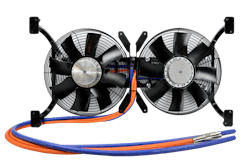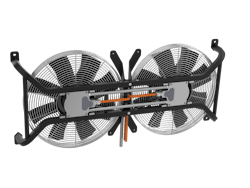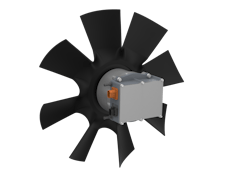Horton Developing High-Voltage Cooling System for Electric Vehicles
Thermal management is an important factor to take into consideration when developing electric vehicles. Electric motors and batteries create heat during operation while power electronics generate heat loss; all of this can lead to a lot of heat in the overall system which can negatively impact performance.
Therefore, it is vital to include proper cooling technology to help mitigate this heat buildup.
Horton Inc. is currently developing a high-voltage cooling system which can be used to keep electric motors, generators and other components operating at optimal temperatures in battery- and fuel cell-electric vehicles.
The company is better known for its engine cooling systems for heavy-duty on- and off-road vehicles and equipment. However, it decided to enter the electric vehicle (EV) space after receiving requests for EV cooling technology from OEM customers said Fernando Pulido, Product Manager (On-Highway Market) at Horton, in an interview with Power & Motion.
“It is important to make sure that we become a part of that [EV] narrative moving forward,” he said. “Because of our strong relationships with our OEM customer base…it puts us in the [position] that even though this is a new territory for us, we are learning together with our OEM customer base.”
READ MORE: Electric Vehicle Development to Grow Over Next Decade
And by working together with its OEM customers in this new electrification space, Horton can not only stay current on industry developments and needs but also ensure it remains part of the supply chain in the future.
System Design
Horton’s high-voltage cooling system consists of a fan, a motor to drive the fan, and an inverter which converts electrical current to AC (alternating current) to run the fan. Pulido said the inverter can either be mounted or integrated into the motor or be mounted elsewhere on the vehicle which is beneficial as electrification often brings about the need to rethink traditional vehicle architectures.
“We are able to use our knowledge and understanding of layout-type restrictions in the vehicle and adapt to the needs and requirements of the customer,” he said.
Another essential element of the system is the mounting rails which ensure the cooling system is mounted correctly on the vehicle. Software is an important aspect as well as it helps run the system and integrates with the OEM’s other systems to ensure optimized performance during vehicle operation.
Pulido said there are key aspects which need to be considered when developing a cooling system such as operating temperatures under the hood of the vehicle. “You are no longer dealing with a diesel engine, you are dealing with a different type of environment…filled with power electronics and batteries,” he said. “They generate a different level of heat [and] operating temperatures” which impacts how the system needs to be designed.
In addition, the working environment itself needs to be taken into consideration. Electromagnetic disturbances may exist with power electronics which should be accounted for and developed around to ensure no negative impacts on system performance.
Horton is developing its high-voltage cooling system for use in both on- and off-highway applications. John Repfennig, Product Manager (Off-Highway Market) at Horton, noted in an interview with Power & Motion there are some different considerations for these systems when used in off-highway equipment.
A key difference is the mounting of the system as there is more diversity in off-highway equipment designs than there are with heavy trucks. In a truck, mounting of the cooling system is almost always the same with the fan and radiator at the front of the vehicle he said. “But in off-highway equipment it could look very different depending on if it is an excavator or a mine haul truck,” explained Repfennig.
When it comes to designing the cooling system, he said the methods utilized are the same as those for engine-powered equipment. It is important to first look at the fan design and determine how much airflow is required to satisfy the cooling needs of the machine. Depending on the size of the machine and its cooling requirements, this could mean multiple fans may be used.
Why Go High Voltage?
When developing electric vehicles, OEMs can choose to use either a low- or a high-voltage system. Typically, anything over 60V is considered high voltage. Many heavier duty applications are moving toward the use of high-voltage systems because of the benefits which can be achieved compared to low-voltage systems.
Pulido said Horton chose to enter the high voltage market because of the advantages it sees for OEM customers “including the possibility to charge the vehicle faster and more efficiently.” There are also some efficiencies possible with the componentry utilized in these systems.
He said another advantage to working in the high-voltage segment is the lack of competition. This is because there is not as much development in the high-voltage space as the low-voltage segment. The latter has been around longer, and therefore is more mature, and is the one used for automotive applications which are higher volume.
READ MORE: Bosch Rexroth Launches Range of Electrification Products for Off-Highway Equipment
While the low-voltage systems are more common and typically available at a lower cost point, Pulido said the disadvantage is those systems do not charge as fast. “According to our OEM [customers], they are putting a lot of stock and value in that.”
Fast charging is important, particularly for a large on-road truck which needs to get from Point A to Point B in a timely manner to meet delivery deadlines. Appropriate charge and run times will be vital to the uptake of electrification in heavy-duty applications, necessitating technology which can aid with this.
With this ability to charge at faster speeds, Pulido said it is important to ensure the cooling system can cope with those speeds. “There is stronger load in those [heavy vehicle] type of duty cycles,” he said. As such, it is necessary to ensure the system can handle the peak potential heating which could occur during vehicle charging.
Collaboration is Key
Overall, working closely with OEM customers is vital to developing the proper cooling system as it is an important aspect of ensuring vehicle uptime. “Uptime is very important in our industry,” said Pulido. “Any time a truck is down, be it for charging purposes—which would be perfectly normal—or any kind of maintenance that needs to be performed, you want to keep that downtime as low as possible.”
Close collaboration with customers ensures systems will work well with one another and the appropriate temperature is maintained for optimized vehicle performance. In addition to minimizing heat build-up, a system may also have to ensure there is enough heat retained particularly if operating in colder climates.
Although many electronic components generate heat, it may be necessary to provide additional heating to ensure batteries start and other components will work in cold weather. Because of the environmental variables which could occur, it is important to discuss with OEMs the thermal management needs of the application so systems can be designed to maintain operation efficiency.
This ensures “we are all on the same page in terms of our targets and our system is tuned as required according to the different operating situations of the vehicle,” said Pulido.
He said collaboration with both the OEM customer and sub-suppliers is beneficial. Being open and honest during the development process is important as well. Working together to understand what is truly necessary for the application and having a high level of transparency will help to ensure the appropriate thermal management solution is developed.
WATCH AND LEARN MORE: 3 Drivers of Off-Highway Electrification
About the Author
Sara Jensen
Executive Editor, Power & Motion
Sara Jensen is executive editor of Power & Motion, directing expanded coverage into the modern fluid power space, as well as mechatronic and smart technologies. She has over 15 years of publishing experience. Prior to Power & Motion she spent 11 years with a trade publication for engineers of heavy-duty equipment, the last 3 of which were as the editor and brand lead. Over the course of her time in the B2B industry, Sara has gained an extensive knowledge of various heavy-duty equipment industries — including construction, agriculture, mining and on-road trucks —along with the systems and market trends which impact them such as fluid power and electronic motion control technologies.
You can follow Sara and Power & Motion via the following social media handles:
X (formerly Twitter): @TechnlgyEditor and @PowerMotionTech
LinkedIn: @SaraJensen and @Power&Motion
Facebook: @PowerMotionTech

Leaders relevant to this article:



